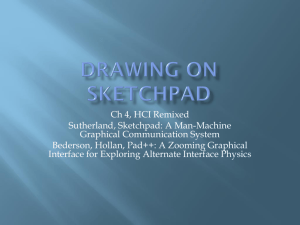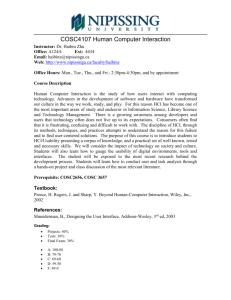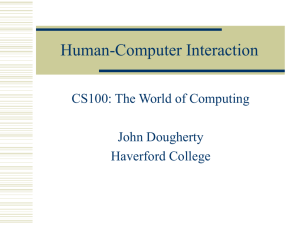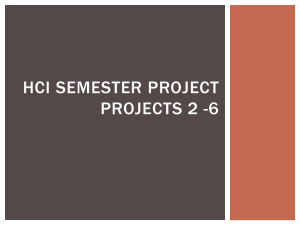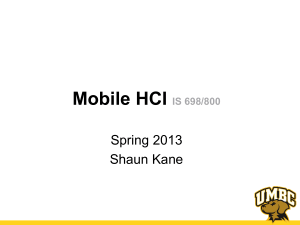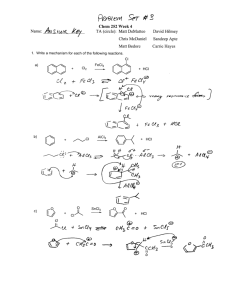Document 13141647
advertisement
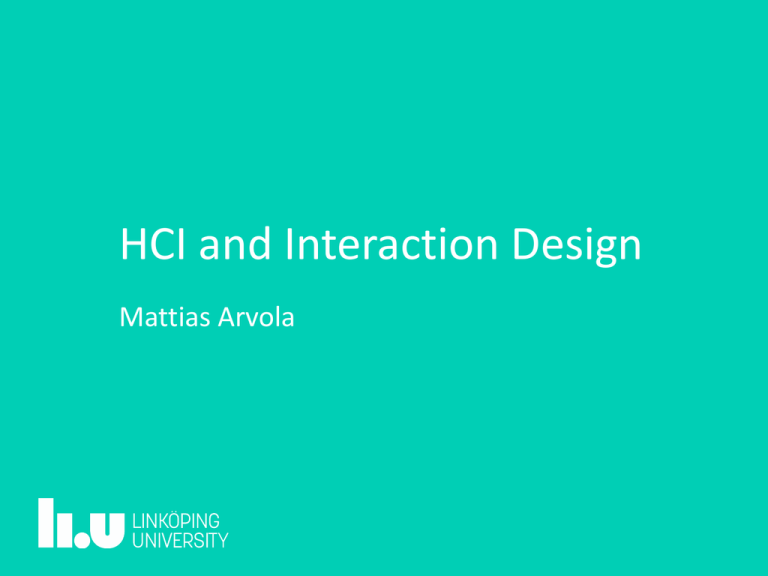
HCI and Interaction Design Mattias Arvola 2 Human-­‐Computer Interaction (Carroll, 2014) • Early 1980s, a specialty area in computer science embracing cognitive science and human factors engineering. • Now aggregates a collection of semi-autonomous fields of research and practice in human-centered informatics. • Computer science, psychology, sociology, anthropology, and design. 3 A definition from ACM • A discipline concerned with the design, evaluation and implementation of interactive computing systems for human use and with the study of major phenomena surrounding them. 4 Command Line Interfaces CLI cp merits.txt ~/personal Copy the file merits.txt to the directory personal in the home directory 5 Menu interfaces • Stepping through hierarchies of menus or screens • 1D or 2D 6 The 90ies • • • • • • Internet Cell phones Digital consumer products Games IT for fun and not only for work Aesthetics, playfullness and social qualities become more important 7 it no longer makes sense to regard HCI as a specialty of computer science; HCI has grown to be broader, larger and much more diverse than computer science itself. […] There is no unified concept of an HCI professional. – Carroll (2014) 8 Graphic User Interfaces GUI • WIMP – Windows, Icons, Menus, Pointers • WYSIWIG – What you see is what you get • Direct manipulation • Spatial representations • Shows actions on the marker 9 The Xerox Star 1980 Apple Lisa 1983 10 Windows 10 11 Mac OS X El Capitan 12 Android Material Design 13 14 Mobile and touch • Less screen real estate means tougher prioritization • A mobile context of use is different from a stationary • What do you need to know, do and feel at this particular moment in this particular context? • Visiting, traveling or local mobility? • What happens when you turn the screen? • Think location-based • Animation • Minimal user help 15 Mobile Input • Touch screen with one or several points of interaction • Soft keyboard • Physical keyboard • Microphone • Physical buttons • Sensors 16 Tangible UIs and Augmented Reality • We are physical beings and interact with the would using our bodies. • We do not only consist of a couple of eyes and an index finger. Why not make use of that in HCI? • Reactable: http://www.youtube.com/ watch?v=vm_FzLya8y4 17 Augmented Reality • Head mounted • Mobile • Projector-based Minnesmark 19 att se vad som döljer sig inne i trädet, vilket illustreras i Figur 66. Genom att gå närmare zoomar användaren in, detta är en interaktionsteknik som skulle kunna kallas rörelsebaserad zoomning (eng. ’ device-movement-based zooming’). Device-­‐movement-­‐based zooming 1. The user sees the hole when directing the camera to the marker. 2. He zooms in by moving closer. 20 att se vad som döljer sig inne i trädet, vilket illustreras i Figur 66. Genom att gå närmare zoomar användaren in, detta är en interaktionsteknik som skulle kunna kallas rörelsebaserad zoomning (eng. ’ device-movement-based zooming’). Device-­‐movement-­‐based panning 1. The user sees the hole when directing the camera to the marker. 2. He zooms in by moving closer. 21 Two-­‐dimensional device-­‐ direc1on based panning 22 Interaction Design – Löwgren (2008) • Interaction Design refers to the shaping of interactive products and services with a specific focus on their use. • Interaction design and the behaviors of the virtual world were before the mid nineties seen as a specialty within industrial design by the design community. 23 Five Major Characteristics of Design • Design involves changing situations by shaping and deploying artifacts • Design is about exploring possible futures • Design entails framing the “problem” in parallel with creating possible “solutions” • Design involves thinking through sketching and other tangible representations • Design addresses instrumental, technical, aesthetical and ethical aspects throughout 24 Design – According to Bruce Archer (1965) 1. There has to be a prior formulation of a prescription or model for a finished work in advance of its embodiment 2. The prescribed formula or model must be embodied in/ as an artefact 3. There must be a creative step in the process 4. It must have purpose. Intent over exploration. 5. It is intuitive but not spontaneous 6. It must begin with a need 7. It must reconcile 8. It must be holistic and consider the artefact in a system and not of itself 9. Design problems are complex 10. Design is about the optimisation of solutions 25 UX Design (Don Norman) • I invented the term because I thought human interface and usability were too narrow. I wanted to cover all aspects of the person’s experience with the system including industrial design, graphics, the interface, the physical interaction, and the manual. Since then the term has spread widely, so much so that it is starting to lose it’s meaning… http://www.adaptivepath.com/ideas/e000862 26 Neither full, nor complete list of UX titles • • • • • • • • Digital Art Director Project manager User researcher Interaction designer Concept, LoFi, HiFi Technical writer Copywriter Prototype Developer • Visual Designer • Usability Tester • … • • • • • Business analyst Branding Marketing Front-end developers … 27 What Interaction Designers Design • • • • • • • Websites Mobile apps Desktop apps Intranets, and communities Interactive spaces and exhibitions Control room displays UI for interactive consumer products • Cross-channel user experiences 28 Interactive Products and Services • Offers people to interact with them, through them or by means of them • To interact mean that users, products and services cooperate, hopefully in harmony and with playful simplicity • Users and products or services act jointly in a coordinated manner in concerts towards a shared goal • Computer-based products and services can respond to or initiate actions which creates a dialogue in the form of a temporal flow 29 By Bill Verplank, whom together with Bill Moggridge invented the term. 30 1. Plan the human-­‐centred process Meets the requirements 2. Understand the context of use 3. Specify user and business 5. Evaluate against requirements 4. Produce design solu1ons A Human-­‐Centered Design Process (ISO 9241-­‐210, 2010) 31 concept revisions detailing 32 Design as reduced uncertainty Known What should be done? Unknown Unknown Known How should it be done? 33 The Task-­‐Artifact Cycle Adoption, appropriation and use Task Artifact Requirements and design ideas fuzzy front end: uncertainty >> pacerns >> insights revisions t pr od uc pr ot ot yp e pt concept co nc e id ea s de sig n cr ite r ia clarity >> focus detailing 34 Intertwined processes – Lundequist (1995) • Information management • Decisions • Managing • Manifestation of ideas appearing (Swe. ’gestaltning’, Ger. ‘gestaltung’) problems 35 36 Current topics and trends • • • • • • Sustainability Systems thinking • Augmented and mixed reality Service design Connectivity Internet of things Context awareness • • • • • Communities Intelligent agents Robots Wearables Sensors 37 Design Ethics • All design builds on a personal stance on how you want to view the world, what is important, and for whom it is important • To what world do you want to contribute? 38 To Conclude • Interaction design is about shaping conditions for people to interact with, through and by means of interactive products and services. 39 Readings • Arvola, M. (2014). Interaktionsdesign och UX: Om att skapa goda användarupplevelser (Ch. 1). Lund: Studentlitteratur. • Carroll, J. M. (2014). Human Computer Interaction - brief intro. In M. Soegaard, and R. F. Dam (Eds.), The Encyclopedia of Human-Computer Interaction, 2nd Ed.. Aarhus, Denmark: The Interaction Design Foundation. https://www.interaction-design.org/encyclopedia/ human_computer_interaction_hci.html (accessed 2014-06-05). • Grudin, J. (1990). The computer reaches out: The historical continuity of interface design. Proc. CHI 90, 261-268. • Grudin, J., & Poltrock, S. (2012). Taxonomy and theory in computer supported cooperative work. In S. W. J. Kozlowski (Ed.), The oxford handbook of organizational psychology (pp. 1323-1348). New York: Oxford University Press. http://research.microsoft.com/en-us/UM/ People/jgrudin/publications/surveys/CSCW.pdf • Löwgren, J. (2008). Interaction Design - brief intro. In M. Soegaard, and R. F. Dam (Eds.), The Encyclopedia of Human-Computer Interaction, 2nd Ed.. Aarhus: The Interaction Design Foundation. http://www.interaction-design.org/encyclopedia/ interaction_design.html (accessed 2013-08-12). • Saffer, D. (2009). Designing for Interaction: Creating Innovative Applications and Devices, 2nd Ed. (Ch. 1-2). Berkeley: New Riders. @mattiasarvola www.liu.se
